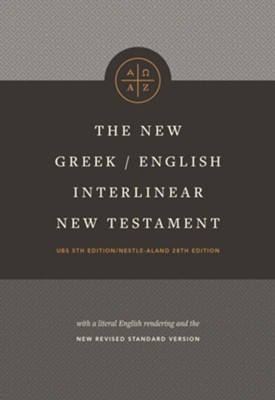
Verses 1-4 are one sentence in the Greek.
ENGLISH GREEK INTERLINEAR BIBLE PHILIPIANS 2 SERIES
9Therefore also God highly exalted Him, and bestowed on Him the name which is above every name, 10so that at the name of Jesus every knee will bow, of those who are in heaven and on earth and under the earth, 11and that every tongue will confess that Jesus Christ is Lord, to the glory of God the Father.Ģ:1 "if" This is the first in a series of four first class conditional sentences which are assumed to be true from the author's perspective or for his literary purposes. 8Being found in appearance as a man, He humbled Himself by becoming obedient to the point of death, even death on a cross. 5Have this attitude in yourselves which was also in Christ Jesus, 6who, although He existed in the form of God, did not regard equality with God a thing to be grasped, 7but emptied Himself, taking the form of a bond-servant, and being made in the likeness of men. 3Do nothing from selfishness or empty conceit, but with humility of mind regard one another as more important than yourselves 4do not merely look out for your own personal interests, but also for the interests of others. 1:17 6:15-16ġ Therefore if there is any encouragement in Christ, if there is any consolation of love, if there is any fellowship of the Spirit, if any affection and compassion, 2make my joy complete by being of the same mind, maintaining the same love, united in spirit, intent on one purpose. Paul does quote other early church hymns, catechismal poems, or liturgical structures in I Tim. It uses several terms not used by Paul anywhere elseĤ. It omits Paul's regular emphasis on Jesus' relation to the Churchģ. It omits the resurrection which was a major and recurrent emphasis of PaulĢ. Jesus is the true object of worship by the will of the Fatherġ. Jesus truly sought our best, not His own, so should ChristiansĤ. Jesus is truly God (in essence, morphē)ģ. The basic truths found in this Christological hymnġ. Bibles that print poetry differently from prose are crucial in seeing the metric pattern and parallelism (cf. OT background is Genesis 3 (Adam/Christ typology)ī. A brief outline of this great hymn to Christī. It seems to divide into two equal emphases.Į. The structure of the hymn to Christ has been debated. for another opinion see Gordon Fee, To What End Exegesis? pp.

Paul quotes other early church hymns, poems, or liturgical structures in I Tim. it is lacking some of the uniquely Pauline theological elements concerning ChristĤ. it contains several rare Greek terms not used by Paulģ. the form is metric, poetical, or lyricalĢ. 2:6-11 seems to be an early Christian hymnġ. In different ways it functions in both areas.Ĭ.

It also deals with the humiliation and exaltation of the pre-existent, incarnated Messiah.ģ. It functions as an example to believers to live selfless, giving lives (cf. 6-11) functions for ethics or for salvation.ġ. There has been much discussion among commentators on how this wonderful hymn to Christ (cf. This context is obviously related to one of the themes of the book, "a call for unity among the Christians at Philippi" (cf. Every paragraph has one and only one main subject.Ī. Paragraphing is not inspired, but it is the key to following the original author's intent, which is the heart of interpretation. Compare your subject divisions with the five modern translations.

You must not relinquish this to a commentator. You, the Bible, and the Holy Spirit are priority in interpretation.

Each of us must walk in the light we have. This is a study guide commentary, which means that you are responsible for your own interpretation of the Bible. READING CYCLE THREE (from " A Guide to Good Bible Reading")įOLLOWING THE ORIGINAL AUTHOR'S INTENT AT THE PARAGRAPH LEVEL PARAGRAPH DIVISIONS OF MODERN TRANSLATIONS


 0 kommentar(er)
0 kommentar(er)
